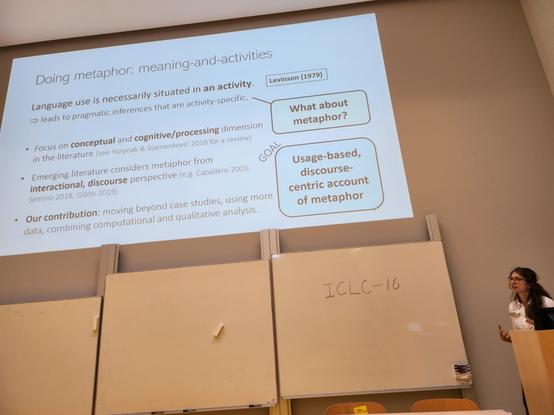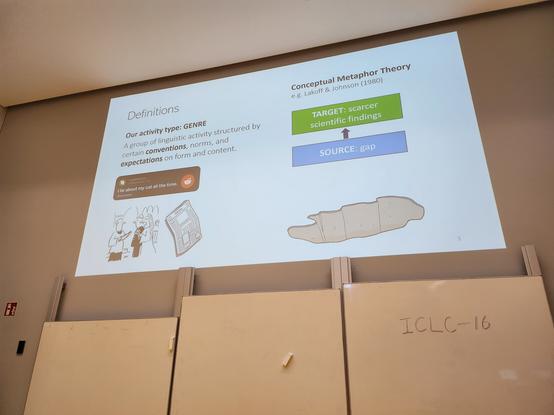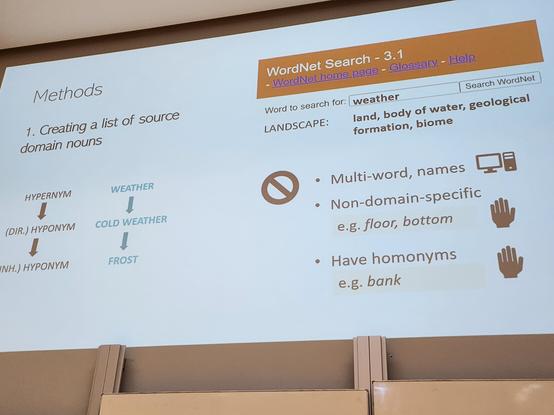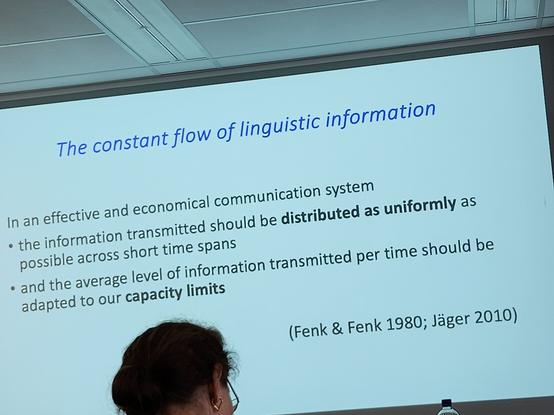Inspiriert durch die #iclc16 und @stefanhartmann gibt es auf dem #NLK24 auch Stopschilder für diejenigen, die einfach nicht aufhören wollen. Zum Einsatz kamen sie aber noch nicht 😄
#iclc16
After the huge #iclc16 conference, I am about to leave for the exact opposite type of event: instead of 14 parallel sessions, just 10 talks at #rtanjLinguistics4, with ample time for discussion. I am talking about "Modification and the nature of adjectives", and I am looking very much forward to everything about this event, including traveling there via Budapest and Belgrad with first train and then bus. https://sites.google.com/view/rtanj/home
If you want to read up on #ICLC16, take a look at @jn‘s megathread starting here https://fediscience.org/@jn/110847328788583288
The sixth day of #iclc16 begins! Looking forward to the plenary by… wait, where is everybody?!?
Huge props to @stefanhartmann and the whole organizing team of #iclc16 for making this a great conference!
Claudia Raihert presents work on metaphor/figurative language in discourse and other genres.
#iclc16
They chose the genres news and fiction and looked at landscape and weather metaphors. Source domains nouns were generated with WordNet, then queried with COCA which resulted in 27/81 keywords.
The theme session on communicative efficiency by Anita Slonimska and Natalia Levshina was really cool! Lots of interesting points raised, and great to see multimodality research represented at #iclc16
Gertraud Fenk-Ocszlon discusses working memory constraints and their implications for efficient coding of MSG's #iclc16
The more predictable, the shorter and first in the sequence. To place high info amount early would lead to cognitive overload.
WM constraints the avg lvl of information being transmitted.
WM = set of processes holding mental representations temporarily available for use in thought & action (Cowan 2017)
Alexander Koplening (with Sascha Wolfer & Peter Meyer) argues that languages trade off complexity against efficiency
#iclc16
All slides on Https://osf.io/prthj/
They present a database of parallel text (many types, religious texts, legal, movie subs) and in addition comparable corpora (not fully parallel, from web crawls)
41 multilingual corpora, 2k languages, spoken by 90% of world population.
Kaius Sinnemäki with Francesca Do Garbo, Eri Kashima & Mark Ellison on communicative efficiency and language contact
#iclc16
Not only discourse, but also grammar and lexicon are organized in an efficient way. But in this research multilingualism and L contact have been neglected (while multilinguism is the norm rather than a deviation).
The slides of my talk "A formal model of lexicogrammatical individuality" are now on Zenodo: https://doi.org/10.5281/zenodo.8233427. The talk expands on my Element ("A Theory of Linguistic Individuality") by proposing a connection with information theory for its mathematical formalisation #ICLC16
Second talk is by Jiahhao Yang & Sotaro Kita on how hearing speakers create manual gestures to benefit comprehension.
#iclc16
The focus of this talk is on silent gesture. We use silent gesture when language is inhibited.
But how to we choose gestural symbols to represent a concept?
For example APPLE could be represented by various associations.so we should great variation.
But research has shown that across cultures people use often EAT AN APPLE rather than other options
Anita Slonimska with @ozyurek_a and Olga Capirci on communicative efficiency in sign languages.
Different modalities have different affordances, like simultaneity in the visual modality.
#iclc16
SLs have linear organization just like spoken language. But the visual affordance allows simultanous iconic depiction. Articulators can be organized in space so that they reflect the relationship in the event.
Alexandre François presents Dialexification, a tool for studying cross-ling patterns of semantic change.
#iclc16
Most studies of colexification are synchronic. To study sem change, like colex links appearing or disappearing one can study common paths via a typological database of lexical change (EvoSem) reconstructing meanings rather than forms using pairs of dialexified senses.
See tiny.cc/EvoSem_ICLC
Our theme session on *Cross-Linguistic Colexifications across Research Fields* is about to start! #ICLC16
Day 4 of #iclc16 starts with a plenary connecting phenomenology and cognitive linguistics. Jordan Zlatev on Merleau-Ponty and the intertwining of bodily experience and language.
Zlatev starts by introducing the relatively young discipline of cognitive semiotics and proposs it as a synthesis of cog sci, cog ling and semiotics informed by phenomenology.
Today at #ICLC16 @saranonpiangere and I have our talk "On responsibility perception in femicide news reports: critical analysis bridging cognitive theories and computational tools" (10:00 in room 3D). Come find us if you're interested!
You thought that the SLE band was awesome? Wait until you hear about the #ICLC16 band! The big surprise from was indeed a band! How cool is that?! Playing amazing covers and their greatest hit "Wait a minute, Mr. Postdoc" 🤩
The third day of #iclc16 ends, like every day in the life of a cognitive linguist, with the brushing of teeth as a metonymy for getting ready for bed.





